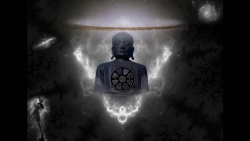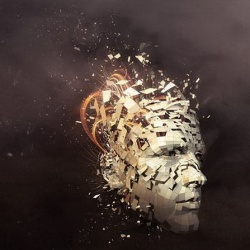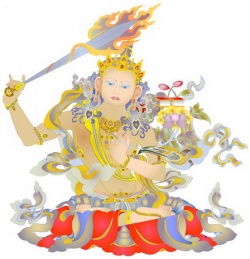Difference between revisions of "Early Shambhala Searchers"
(Created page with "Mipham believed Shambhala to be north of the River Tarim..."One travels north to the region of Khotan (Li Yul). Nearbye is the Tarim River (Shing rta---Sita) which flows from ...") |
|||
| (2 intermediate revisions by 2 users not shown) | |||
| Line 1: | Line 1: | ||
| − | Mipham believed Shambhala to be north of the River Tarim..."One travels north to the region of Khotan (Li Yul). Nearbye is the Tarim River (Shing rta---Sita) which flows from west to east. In this region live the Uighurs (Hor). North of the Tarim lie the Tian Shan mountains that make up the southern boundary of Shambhala." (Cabezon: 1996...pg 488)... | + | {{DisplayImages|887|1321|437}} |
| + | [[Mipham]] believed [[Shambhala]] to be [[north]] of the [[River]] Tarim..."One travels [[north]] to the region of [[wikipedia:Khotan|Khotan]] (Li Yul). Nearbye is the Tarim [[River]] (Shing rta---Sita) which flows from [[west]] to [[east]]. In this region [[live]] the {{Wiki|Uighurs}} (Hor). [[North]] of the Tarim lie the Tian Shan mountains that make up the southern boundary of [[Shambhala]]." (Cabezon: 1996...pg 488)... | ||
| − | Chatral Rinpoche believes that Gurdjieff spent several years in a monastery in the Swat valley.....first gained access to the central Sarmoun monastery in 1899-1900 and it appears likely that he had a more extended stay in 1906-1907. At the end of 1907 Gurdjieff went to Tashkent to practice healing.... Chitral is drained by the Kunar River which flows southward, through Afghanistan, to meet the East flowing Kabul River, which in times past, was known as the Sita, or White River. In the year 1900 the Russian mystic George Ivanovitch Gurdjieff traveled by raft down part of this dangerous river, as part of an expedition led by Prof. Kozlov in search of the ruins of ancient Shambhala. | + | [[Chatral Rinpoche]] believes that Gurdjieff spent several years in a [[monastery]] in the {{Wiki|Swat}} valley.....first gained access to the central Sarmoun [[monastery]] in 1899-1900 and it appears likely that he had a more extended stay in 1906-1907. At the end of 1907 Gurdjieff went to Tashkent to practice [[healing]].... Chitral is drained by the Kunar [[River]] which flows southward, through {{Wiki|Afghanistan}}, to meet the [[East]] flowing {{Wiki|Kabul}} [[River]], which in times past, was known as the [[Sita]], or White [[River]]. In the year 1900 the {{Wiki|Russian}} [[mystic]] George Ivanovitch Gurdjieff traveled by raft down part of this [[dangerous]] [[river]], as part of an expedition led by Prof. Kozlov in search of the ruins of {{Wiki|ancient}} [[Shambhala]]. |
| − | Foster, Barbara and Michael. The Secret Lives of Alexandra David-Neel - A Biography of the Explorer of Tibet and Its Forbidden Practices. ISBN 1-58567-329-3; American edition under the title Forbidden Journey - The Life of Alexandra David-Neel, ISBN 0-06-250345-6. This book is based on extensive interviews with David Neel's secretary at Digne and reading her letters to her husband, now published as "Journal de voyage: lettres a son mari." | + | Foster, Barbara and Michael. The Secret [[Lives]] of {{Wiki|Alexandra David-Neel}} - A {{Wiki|Biography}} of the Explorer of [[Tibet]] and Its Forbidden Practices. ISBN 1-58567-329-3; American edition under the title Forbidden Journey - The [[Life]] of {{Wiki|Alexandra David-Neel}}, ISBN 0-06-250345-6. This [[book]] is based on extensive interviews with David Neel's secretary at Digne and reading her letters to her husband, now published as "Journal de voyage: lettres a son mari." |
| − | In any event, Ossendowski did not invent the story of a fabulous land secreted somewhere in – or under – the vastness of Central Asia, be it called Agharti, Agarttha, Shangri-la, or, most commonly, Shambhala.6 Some believed it to be a physical, subterranean realm inhabited by an ancient, advanced race, while to others it was a spiritual dimension accessible only to the enlightened. The Shambhala legend is firmly grounded in Buddhist tradition which vaguely puts the Kingdom somewhere to the north of India. The legend also proclaimed that a time would come when the King of Shambhala and his mighty hosts would come forth to vanquish evil and usher in a golden age guided by pure Dharma. As noted, Baron von Ungern-Sternberg envisioned himself as the initiator of this | + | In any event, {{Wiki|Ossendowski}} did not invent the story of a fabulous land secreted somewhere in – or under – the vastness of {{Wiki|Central Asia}}, be it called [[Agharti]], Agarttha, [[Shangri-la]], or, most commonly, Shambhala.6 Some believed it to be a [[physical]], subterranean [[realm]] inhabited by an {{Wiki|ancient}}, advanced race, while to others it was a [[spiritual]] [[dimension]] accessible only to the [[enlightened]]. The [[Shambhala]] legend is firmly grounded in [[Buddhist tradition]] which vaguely puts the {{Wiki|Kingdom}} somewhere to the [[north]] of [[India]]. The legend also proclaimed that a [[time]] would come when the [[King of Shambhala]] and his mighty hosts would come forth to vanquish [[evil]] and usher in a golden age guided by [[pure]] [[Dharma]]. As noted, [[Baron von Ungern-Sternberg]] envisioned himself as the initiator of this “[[Shambhala]] [[War]].” So would others. |
| − | Roerich brought key knowledge to this mission. In the 1920s it is rumored that he went on a mission to find and return what was said to be part of the sacred | + | [[Roerich]] brought key [[knowledge]] to this [[mission]]. In the 1920s it is rumored that he went on a [[mission]] to find and return what was said to be part of the [[sacred]] ‘[[Chintamani Stone]]’, the stone of [[Shambhala]], which was believed to be part of a [[magical]] meteorite.....Roerich said this ‘black stone’ appeared at [[vital]] moments in [[human]] history as an evolutionary force. It seems that FDRoosevelt sent him back in 1934 to recover this Stone once again....In 1935, at the request of [[Roerich]] and Wallace and apparently in celebration of their [[success]], FDR abruptly ordered the [[Great Seal]] of the [[United States]] bearing the All-Seeing [[Eye]] [[symbol]] stamped on the back of the one dollar bill. To Masons, such as Wallace and FDR, this [[symbol]] represents the return of the the Sol Eye....When FDR posted this [[symbol]] bearing the phrase NOVUS ORDO SECLORUM – New Order of the Ages - it proclaimed the promised new order or new deal had arrived. |
| − | The Sanskrit and Tibetan Shambhala has also been identified by no less an authority than Alexandra David-Neel, who spent years in Tibet, with Balkh – in the far north of Afghanistan – the ancient settlement known as "the mother of cities". Present day folklore in Afghanistan asserts that after the Muslim conquest, Balkh was known as the "Elevated Candle" ("Sham-i-Bala"), a Persianisation of the Sanskrit Shambhala. | + | The [[Sanskrit]] and [[Tibetan]] [[Shambhala]] has also been identified by no less an authority than {{Wiki|Alexandra David-Neel}}, who spent years in [[Tibet]], with Balkh – in the far [[north]] of {{Wiki|Afghanistan}} – the {{Wiki|ancient}} settlement known as "the mother of cities". Present day {{Wiki|folklore}} in {{Wiki|Afghanistan}} asserts that after the [[Muslim]] conquest, Balkh was known as the "Elevated Candle" ("Sham-i-Bala"), a Persianisation of the [[Sanskrit]] [[Shambhala]]. |
| − | This research explores my understanding that historically and geographically, the 'legendary' Kingdom of Shambhala was located in the region of Shamis en Balkh (Sham-i-Bala, Bactra, Zariasta)....the great ancient city in Bactria (a region possibly known as Tagzig, Oddiyana, Olmo Lungring) and the great rich and fertile region surrounded by the Pamir and Hindu Kush Mountains. | + | This research explores my [[understanding]] that historically and geographically, the 'legendary' [[Kingdom of Shambhala]] was located in the region of Shamis en Balkh (Sham-i-Bala, [[Bactra]], Zariasta)....the great {{Wiki|ancient}} city in {{Wiki|Bactria}} (a region possibly known as [[Tagzig]], [[Oddiyana]], [[Olmo Lungring]]) and the great rich and {{Wiki|fertile}} region surrounded by the {{Wiki|Pamir}} and [[Hindu]] Kush Mountains. |
{{R}} | {{R}} | ||
[http://balkhandshambhala.blogspot.com.au/2012/11/balkh-early-shambhala-searchers.html balkhandshambhala.blogspot.com.au] | [http://balkhandshambhala.blogspot.com.au/2012/11/balkh-early-shambhala-searchers.html balkhandshambhala.blogspot.com.au] | ||
Latest revision as of 05:31, 21 November 2013
Mipham believed Shambhala to be north of the River Tarim..."One travels north to the region of Khotan (Li Yul). Nearbye is the Tarim River (Shing rta---Sita) which flows from west to east. In this region live the Uighurs (Hor). North of the Tarim lie the Tian Shan mountains that make up the southern boundary of Shambhala." (Cabezon: 1996...pg 488)...
Chatral Rinpoche believes that Gurdjieff spent several years in a monastery in the Swat valley.....first gained access to the central Sarmoun monastery in 1899-1900 and it appears likely that he had a more extended stay in 1906-1907. At the end of 1907 Gurdjieff went to Tashkent to practice healing.... Chitral is drained by the Kunar River which flows southward, through Afghanistan, to meet the East flowing Kabul River, which in times past, was known as the Sita, or White River. In the year 1900 the Russian mystic George Ivanovitch Gurdjieff traveled by raft down part of this dangerous river, as part of an expedition led by Prof. Kozlov in search of the ruins of ancient Shambhala.
Foster, Barbara and Michael. The Secret Lives of Alexandra David-Neel - A Biography of the Explorer of Tibet and Its Forbidden Practices. ISBN 1-58567-329-3; American edition under the title Forbidden Journey - The Life of Alexandra David-Neel, ISBN 0-06-250345-6. This book is based on extensive interviews with David Neel's secretary at Digne and reading her letters to her husband, now published as "Journal de voyage: lettres a son mari."
In any event, Ossendowski did not invent the story of a fabulous land secreted somewhere in – or under – the vastness of Central Asia, be it called Agharti, Agarttha, Shangri-la, or, most commonly, Shambhala.6 Some believed it to be a physical, subterranean realm inhabited by an ancient, advanced race, while to others it was a spiritual dimension accessible only to the enlightened. The Shambhala legend is firmly grounded in Buddhist tradition which vaguely puts the Kingdom somewhere to the north of India. The legend also proclaimed that a time would come when the King of Shambhala and his mighty hosts would come forth to vanquish evil and usher in a golden age guided by pure Dharma. As noted, Baron von Ungern-Sternberg envisioned himself as the initiator of this “Shambhala War.” So would others.
Roerich brought key knowledge to this mission. In the 1920s it is rumored that he went on a mission to find and return what was said to be part of the sacred ‘Chintamani Stone’, the stone of Shambhala, which was believed to be part of a magical meteorite.....Roerich said this ‘black stone’ appeared at vital moments in human history as an evolutionary force. It seems that FDRoosevelt sent him back in 1934 to recover this Stone once again....In 1935, at the request of Roerich and Wallace and apparently in celebration of their success, FDR abruptly ordered the Great Seal of the United States bearing the All-Seeing Eye symbol stamped on the back of the one dollar bill. To Masons, such as Wallace and FDR, this symbol represents the return of the the Sol Eye....When FDR posted this symbol bearing the phrase NOVUS ORDO SECLORUM – New Order of the Ages - it proclaimed the promised new order or new deal had arrived.
The Sanskrit and Tibetan Shambhala has also been identified by no less an authority than Alexandra David-Neel, who spent years in Tibet, with Balkh – in the far north of Afghanistan – the ancient settlement known as "the mother of cities". Present day folklore in Afghanistan asserts that after the Muslim conquest, Balkh was known as the "Elevated Candle" ("Sham-i-Bala"), a Persianisation of the Sanskrit Shambhala.
This research explores my understanding that historically and geographically, the 'legendary' Kingdom of Shambhala was located in the region of Shamis en Balkh (Sham-i-Bala, Bactra, Zariasta)....the great ancient city in Bactria (a region possibly known as Tagzig, Oddiyana, Olmo Lungring) and the great rich and fertile region surrounded by the Pamir and Hindu Kush Mountains.


